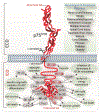In vivo functions of p75NTR: challenges and opportunities for an emerging therapeutic target
- PMID: 34334250
- PMCID: PMC8502531
- DOI: 10.1016/j.tips.2021.06.006
In vivo functions of p75NTR: challenges and opportunities for an emerging therapeutic target
Abstract
The p75 neurotrophin receptor (p75NTR) functions at the molecular nexus of cell death, survival, and differentiation. In addition to its contribution to neurodegenerative diseases and nervous system injuries, recent studies have revealed unanticipated roles of p75NTR in liver repair, fibrinolysis, lung fibrosis, muscle regeneration, and metabolism. Linking these various p75NTR functions more precisely to specific mechanisms marks p75NTR as an emerging candidate for therapeutic intervention in a wide range of disorders. Indeed, small molecule inhibitors of p75NTR binding to neurotrophins have shown efficacy in models of Alzheimer's disease (AD) and neurodegeneration. Here, we outline recent advances in understanding p75NTR pleiotropic functions in vivo, and propose an integrated view of p75NTR and its challenges and opportunities as a pharmacological target.
Trial registration: ClinicalTrials.gov NCT03069014.
Keywords: Alzheimer’s disease; fibrinolysis; neurodegenerative diseases; neurotrophin receptors; small molecule inhibitors.
Copyright © 2021 Elsevier Ltd. All rights reserved.
Conflict of interest statement
Declaration of interest No interests are declared.
Figures



References
-
- Barker PA (2004) p75NTR is positively promiscuous: novel partners and new insights. Neuron 42 (4), 529–33. - PubMed
-
- Hempstead BL (2002) The many faces of p75NTR. Curr Opin Neurobiol 12 (3), 260–7. - PubMed
-
- Dechant G and Barde YA (2002) The neurotrophin receptor p75(NTR): novel functions and implications for diseases of the nervous system. Nat Neurosci 5 (11), 1131–6. - PubMed
-
- Johnson D et al. (1986) Expression and structure of the human NGF receptor. Cell 47 (4), 545–54. - PubMed
-
- Radeke MJ et al. (1987) Gene transfer and molecular cloning of the rat nerve growth factor receptor. Nature 325 (6105), 593–7. - PubMed

